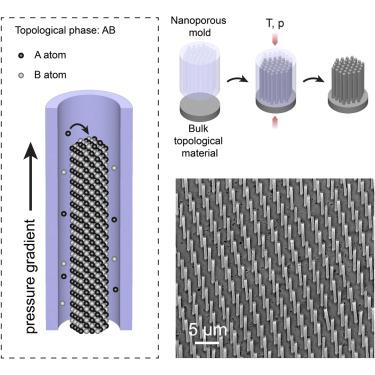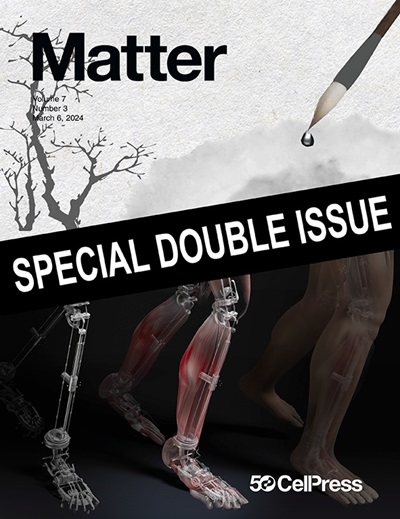Realizing one-dimensional single-crystalline topological nanomaterials through thermomechanical epitaxy
IF 17.5
1区 材料科学
Q1 MATERIALS SCIENCE, MULTIDISCIPLINARY
引用次数: 0
Abstract
Applications and characterizations of topological materials benefit from nanostructures where enhanced surface-to-volume ratios amplify topological states. However, realizing one-dimensional topological nanomaterials has been limited by existing fabrication methods. Here, we present thermomechanical epitaxy (TME)—a general technique for fabricating one-dimensional topological nanomaterials. By applying pressure on bulk topological materials against rigid nanocavities, interface diffusion drives epitaxial growth of high-quality, single-crystalline nanowires at wafer scale. As this diffusional mechanism is prevalent across general materials, it enables a versatile approach to realize one-dimensional nanomaterials from a diverse spectrum of topological phases covering topological insulators and topological semimetals and realize one-dimensional nanomaterials that have not been achieved with state-of-the-art technology. Our theoretical framework predicts materials suitable for TME by correlating phase stability with pressure-induced chemical potential. The proposed method expands the accessible space of topological nanomaterials and bolsters the potential for advancements in physical science and next-generation nanodevices.

通过热机械外延实现一维单晶拓扑纳米材料
拓扑材料的应用和表征得益于纳米结构,其中增强的表面体积比放大了拓扑状态。然而,实现一维拓扑纳米材料受到现有制造方法的限制。在这里,我们提出了热机械外延(TME) -一种制造一维拓扑纳米材料的通用技术。通过对刚性纳米空腔施加压力,界面扩散驱动高质量单晶纳米线在晶圆尺度上的外延生长。由于这种扩散机制在一般材料中普遍存在,它使得从包括拓扑绝缘体和拓扑半金属在内的不同拓扑相光谱中实现一维纳米材料成为一种通用的方法,并实现了当前技术尚未实现的一维纳米材料。我们的理论框架通过将相稳定性与压力诱导化学势相关联来预测适合TME的材料。所提出的方法扩展了拓扑纳米材料的可访问空间,增强了物理科学和下一代纳米器件的发展潜力。
本文章由计算机程序翻译,如有差异,请以英文原文为准。
求助全文
约1分钟内获得全文
求助全文
来源期刊

Matter
MATERIALS SCIENCE, MULTIDISCIPLINARY-
CiteScore
26.30
自引率
2.60%
发文量
367
期刊介绍:
Matter, a monthly journal affiliated with Cell, spans the broad field of materials science from nano to macro levels,covering fundamentals to applications. Embracing groundbreaking technologies,it includes full-length research articles,reviews, perspectives,previews, opinions, personnel stories, and general editorial content.
Matter aims to be the primary resource for researchers in academia and industry, inspiring the next generation of materials scientists.
 求助内容:
求助内容: 应助结果提醒方式:
应助结果提醒方式:


